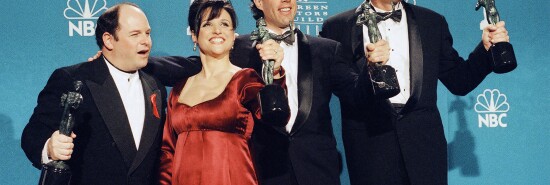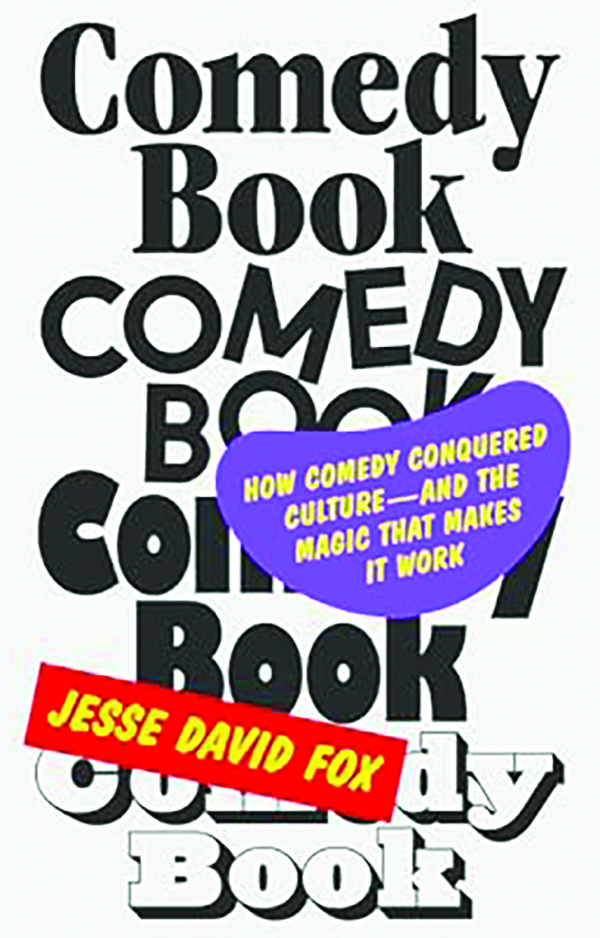
What is comedy? And can a comedy journalist tell you in a book?
Patrick DiMarchi
In 1989, the same year Seinfeld premiered, no comedian had ever headlined at Madison Square Garden. Since then, nearly 20 comedians have done so. Comedy is changing, and its icons have permeated culture in a way that it would take several comedy books to chronicle, if anyone wanted a Comedy History Reference volume set. Nobody does, so instead, we now have Comedy Book, a light look from Vulture writer Jesse David Fox at how comedy works and why its position in American cultural life is now, despite many claims to the contrary, higher than it has ever been.

Comedy Book takes the reader on a journey through comedic history to prove its thesis about the cultural ascendancy of comedy. With a bullet list of comedic categories, Fox guides the reader through the world of comedy to show you that there is an “us” for every one of us out there. The how of it is answered and extended upon later by another question, “What is comedy?” — the whole time hoping you’ll ask if it’s art, making light and brief mention of the fact that comedy suffers from artistic imposter syndrome brought on by a lack of seriousness inherent in the act of making others laugh. The fact that comedy is, as defined by the author, “the art of taking serious things not seriously” does nothing to help its argument. But it does make you wonder: Where would we be without it?
A MISERABLE JOURNEY THROUGH THE HISTORY OF POETRY WITH JEREMY CORBYN, EUROPE’S MOST SUCCESSFUL RACIST POLITICIAN
Through a series of comedic cultural references, we’re reminded of how Saturday Night Live, The Simpsons, and Seinfeld have each permeated our minds and lexicons and often dictated the directions of our laughs. Along the way, the case is made for how each one represents some level of intellectual superiority. Fox describes how Harvard writers, hailing from the legendary campus Lampoon, make up one easily comprehensible path to popular success in telling the jokes that make American comedy the way(s) it is, representing the minds behind the magic in some of the strangest of writing rooms. He describes the lackadaisical nature of the Seinfeld ethos, which took everyday nuance and translated it onto the screen the way, in art history, realists put pictures of plain people doing plain things on the walls of museums. Or take SNL, which isn’t only a part of culture but also a constant reflection of contemporary comedy viewers everywhere each week for the last 49 seasons, with more or less success.
One of the curious features of the history of the rise and rise of comedy is that it has now been declared dead and, in fact, has always been being declared dead. Whether the declarations have any truth to them depends entirely on how you look at them. Fox looks, for example, at the prime-time TV comedy show, noting it has been dying a slow death since its apex with Seinfeld, when 76 million of America’s then-276 million people were tuned in to the same thing at the same time, for the last time. Part of why there is no current equivalent of Seinfeld has less to do with comedy and more to do with television overall. Game of Thrones had only 20 million viewers on the night of its finale. Yet despite the (relative) downfall of the sitcom, stand-up itself has grown like no other. One way of looking at this for a comedy votary is gloomy, but another is to be happy that consumers now want their stuff pure and uncut.
Stand-up sits in a complicated space that makes it the inheritor of the tradition of the great orators, our Ciceros, yet also of jesters and freaks. In stand-up, comedy and fame react on one another. Comedy makes fame, and fame makes comedy. As Fox makes his case for comedy conquering culture, it becomes obvious that certain stand-up comedians have killed with certain crowds long enough to call them captured. Recognizing the range of comedic spectrums, there is an argument for a world of comedians separated by the likes of Jerry Seinfeld and Dave Chappelle, an inoffensive comedic terminator creating generationally loved comedy contrasting with an outrageous one who doesn’t believe in safe spaces and intentionally pushes the bounds. These stand-up titans can do what they do because they have done what they have done, but nobody who isn’t already famous could get away with their acts — they’d be considered either too boring or too edgy. Or both.
CLICK HERE TO READ MORE FROM THE WASHINGTON EXAMINER
Comedy did not conquer culture. Comedy reflects some version of culture. And we live in an age in which every thought is captured. It’s the world that is more connected, and laughter is the easiest thing to bring us all together. While the songs of the past were five-minute marvels enjoyed in only immediate company, the new generation seeks connection in seven seconds of crowd work from a shaky camera, shared among millions online, only roughly at the same time.
So, the internet, the character necessarily lurking in the background of every scene of this book. Any book named Comedy Book purporting to give a history of the evolution and cultural purchase of the thing is going to have to reckon with it, and Fox tries. Memes are funny, he ventures, but they’re not actually comedy by his high-flown definition of the art form. He goes on to ask, “Why does comedy exist?”
The answers to this question can be found where distinct realities come into conflict. One reality is that comedy is there to make us laugh. But by the standards of other realities, it’s enough just to be a part of an art, recognized or not, that relieves tension — to take the serious unseriously, as the author states. The author calls it valuable but not funny. Which, aside from a few purposefully inserted jokes from some of the greats, is exactly what this book is.
Patrick DiMarchi is the author of Chasing The Mic: A Story of Self-Censorship & American Counterculture in a time when NOTHING is funny.
